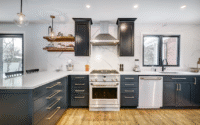Concrete Floors in Home: Stylish, Durable, and Easy to Maintain
When it comes to modern home design, concrete floors in home interiors are increasingly popular among homeowners seeking a blend of durability, style, and easy maintenance. From sleek polished finishes to decorative stained or textured surfaces, concrete offers versatility that traditional flooring materials often cannot match. Whether you’re renovating your living room, upgrading your kitchen, or finishing a basement, concrete floors provide a modern, clean aesthetic that complements almost any decor style.
In this article, we’ll explore the benefits of concrete floors, popular design options, maintenance tips, and even a real-life case study, so you can make an informed decision about whether concrete flooring is right for your home.

Content
Why Choose Concrete Floors in Home
Concrete floors in home are no longer limited to industrial or garage spaces. Modern indoor concrete flooring offers several advantages:
- Durability and Longevity – Concrete is highly resistant to wear and tear. With proper sealing, polished or stained floors can last decades without major repairs.
- Low Maintenance – Unlike hardwood or carpet, concrete floors require minimal upkeep. Regular sweeping and occasional resealing keep them looking new.
- Design Flexibility – With options like epoxy coatings, staining, polishing, and decorative aggregates, concrete can match almost any aesthetic.
- Energy Efficiency – Concrete has excellent thermal mass, helping regulate indoor temperatures and reduce heating and cooling costs.
- Cost-Effectiveness – Compared to premium hardwood or natural stone, concrete floors provide a durable, attractive option at a fraction of the price.
Popular Design Options for Concrete Floors
Concrete floors are highly customizable. Here are some of the most sought-after concrete floor finish ideas:
1. Polished Concrete
Polished concrete offers a glossy, mirror-like finish that reflects light and makes spaces appear larger. Ideal for living rooms and kitchens, this finish pairs well with modern, minimalist, or industrial decor. Many homeowners love polished floors because they are easy to clean and maintain.
2. Stained Concrete
Stained concrete allows you to add color and depth. Acid stains, water-based stains, or metallic stains create unique patterns and tones, giving your floor a natural stone or marble-like appearance. This option is excellent for homeowners looking for stylish concrete floors in home design ideas.
3. Exposed Aggregate
An exposed aggregate finish reveals small stones or pebbles embedded in the concrete, creating a textured, natural look. This option is not only visually appealing but also slip-resistant, making it suitable for kitchens, bathrooms, or outdoor patios.
4. Decorative Overlays
Concrete overlays allow you to apply thin layers of new material on existing floors, offering endless decorative possibilities. You can mimic tile, stone, or wood patterns without replacing your old flooring.
5. Epoxy Concrete Floors
Epoxy coatings provide a durable, glossy finish that can resist stains, chemicals, and heavy foot traffic. Often used in basements, garages, or home gyms, epoxy floors also allow for decorative patterns and color customization.
Maintenance Tips for Concrete Floors

Maintaining concrete floors is simple but requires attention to prevent staining or damage, especially when creating clean and cohesive Floor Plans for your home. Regular Cleaning – Sweep or vacuum regularly to remove dust and debris, and damp mop with a mild cleaner as needed.
Seal Your Floors – Sealing concrete helps protect against stains and moisture damage. Reapply sealant every few years for best results.
Avoid Harsh Chemicals – Strong acids or abrasive cleaners can damage the surface. Stick to pH-neutral cleaners.
Use Rugs Strategically – Place rugs in high-traffic areas to reduce wear and prevent scratches.
Following these steps ensures that your concrete floors maintain their beauty and longevity while remaining functional for daily life.
Real-Life Case Study: Transforming a Living Room with Concrete Floors
The Martins, a young couple in Denver, were renovating their 1,800 sq. ft. home. They wanted flooring that could handle their energetic toddlers, resist spills, and still look stylish for entertaining guests. Hardwood and carpet were dismissed due to maintenance concerns.
The Solution:
They chose polished and lightly stained concrete floors for their living room, kitchen, and hallways. The polished finish added shine, while the stain gave a warm, inviting tone that complemented their furniture. Epoxy-coated concrete was used in their basement play area for extra durability.
The Result:
The home instantly felt modern, spacious, and easy to clean. Their guests often compliment the sleek, seamless flooring, and the couple appreciates how low-maintenance it is, especially with kids. Their home not only looks stylish but also functions perfectly for family life.
This example demonstrates the versatility, practicality, and aesthetic appeal of concrete floors in home interiors.
Factors to Consider Before Installing Concrete Floors
When planning to install concrete floors, it’s important to consider:
- Room Function – Kitchens, bathrooms, and high-traffic areas may require additional sealing or textured finishes.
- Subfloor Quality – Concrete must be level and crack-free before finishing. Existing slab conditions may require resurfacing.
- Finish Choice – Polished, stained, or epoxy-coated floors each have different visual effects, maintenance requirements, and costs.
- Budget – While concrete is generally cost-effective, decorative finishes, labor, and sealers can add to the final expense.
- Comfort – Concrete is naturally hard; consider underfloor heating or rugs in areas where you stand frequently.
Pros and Cons of Concrete Floors in Home
Pros:
- Durable and long-lasting
- Low-maintenance and easy to clean
- Modern, stylish look
- Versatile in finishes and colors
- Energy-efficient
Cons:
- Can be cold and hard underfoot
- Requires professional installation for polished or decorative finishes
- May crack over time without proper subfloor prep
This balanced overview helps homeowners make an informed decision when searching for affordable concrete flooring options for home.
Tips for Choosing the Right Concrete Finish

- Match the floor finish with your interior style: polished for modern, stained for warm and natural, textured for safety and rustic appeal.
- Consider traffic and usage: epoxy and overlays are ideal for areas with heavy wear or moisture.
- Think long-term: higher upfront cost for polished or stained floors may save money in maintenance over time.
A thoughtful approach ensures your concrete floors in home remain functional, attractive, and durable for years to come.
Conclusion: Are Concrete Floors Right for Your Home?
Concrete floors offer a stylish, durable, and low-maintenance option for homeowners who want a modern and versatile flooring solution. With multiple design options like polished, stained, epoxy-coated, and exposed aggregate, these floors can suit almost any decor and lifestyle.
By considering room function, finish choice, and maintenance requirements, you can select the ideal concrete floor for your home. Real-life examples, like the Martins’ renovated living space, show that concrete can be both beautiful and practical, making it a worthy investment for any residential project.
Whether you’re aiming for elegance, modern minimalism, or durability for family life, concrete floors in home interiors provide a perfect balance of style, functionality, and long-term value. For more information visit our website home2choose
FAQ’s:
Is it cheaper to have concrete floors?
Yes, concrete floors are generally more affordable than hardwood or stone while offering durability and low maintenance.
Why do houses have concrete floors?
Concrete floors are chosen for durability, energy efficiency, easy maintenance, and versatile design options.
What is the purpose of a concrete floor?
They provide a strong, long-lasting surface suitable for modern interiors and high-traffic areas.
Are concrete floors better than wood?
Concrete lasts longer, is more durable, and requires less maintenance, though wood may feel warmer underfoot.

Connie is a dedicated home improvement blog author who has a passion for writing. She enjoys blogging about all sorts of topics, from interior design to landscaping and more! She loves the outdoors and spending time in nature with her family. She also likes to bake in her free time.


